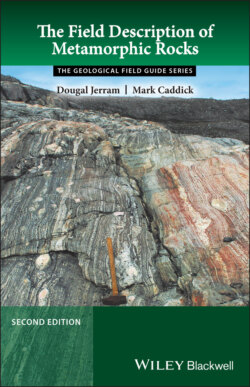The Field Description of Metamorphic Rocks

Реклама. ООО «ЛитРес», ИНН: 7719571260.
Оглавление
Dougal Jerram. The Field Description of Metamorphic Rocks
Table of Contents
List of Tables
List of Illustrations
Guide
Pages
The Geological Field Guide Series
The Field Description of Metamorphic Rocks
PREFACE – THE FIELD DESCRIPTION OF METAMORPHIC ROCKS
Preface – Meet the Authors
ACKNOWLEDGMENTS
1 INTRODUCTION AND OCCURRENCE
1.1 The Importance of Fieldwork in Metamorphic Terrains
1.2 Understanding Metamorphism; Pressure/Temperature Relationships
1.3 Mode of Occurrence of Metamorphic Bodies
1.3.1 Regional metamorphic rocks
1.3.2 Subduction zone rocks
1.3.3 Contact metamorphic rocks
1.3.4 Hydrothermal metamorphic rocks
1.4 Summary
2 FIELD SKILLS AND MAPPING OUTCROP STRUCTURES
2.1 Equipment
2.2 Preparing Maps and Basic Mapping
2.3 Notebooks and Data Recording
2.3.1 Field sketches
2.3.2 Logging – graphic logs
2.3.3 What to record and mapping at different scales
2.3.4 Sample collection, naming, and recording
2.3.5 The nature of particular contacts
2.4 Digital 3D Outcrop Mapping
3 METAMORPHIC MINERALS, ROCK TYPES, AND CLASSIFICATION
3.1 Minerals
3.1.1 Recording assemblages, proportions, and properties
3.1.2 Mineral identification
3.2 The Basic Classification of Metamorphic Rocks in P‐T
3.3 Metamorphic Rock Names
3.3.1 Mineral‐based rock names
3.3.2 Names based on pre‐metamorphic type
3.3.3 Names of fine‐grained metamorphic rocks
3.4 Reporting Rock Types
3.4.1 Moderate‐ to coarse‐grained rocks
3.4.2 Fine‐grained patches, pseudomorphs, and mylonite streaks
3.4.3 Fine‐grained rocks
3.5 Compositional Category and Metamorphic Grade
3.5.1 Grade of metamorphism
3.5.2 Triangular (compatibility) diagrams and grade of metamorphism
3.5.3 Major compositional categories
3.5.4 Mafic (also called basic) and intermediate igneous (compositional category B)
3.5.5 Pelitic rocks (compositional category E+)
3.5.6 Marbles and calc‐silicates (compositional categories F and G) and fluids
3.5.7 Mafic calc‐silicate composition overlap (categories B and G)
3.5.8 The loss of white mica + quartz: ‘high grade’
4 UNDERSTANDING TEXTURES AND FABRICS 1: BANDING, CLEAVAGE, SCHISTOSITY, AND LINEATIONS
4.1 General Terminology
4.1.1 Causes of compositional complexity
4.1.2 Destruction of compositional complexity
4.2 Rocks without a Metamorphic Directional Fabric
4.3 Banding
4.3.1 Gross ‘large‐scale’ banding
4.3.2 Fine‐scale banding and striping
4.3.3 Recording banding in the field
4.4 The Development of Fabric, Cleavage, Schistosity, and Lineations
4.4.1 Mineral and shape fabrics
4.4.2 Fabric symmetry
4.4.3 Fabric origin and grade
4.4.4 Slate fabrics, cleavages, schistosities, and lineations
4.4.5 Gneiss banding and migmatites
4.5 Refraction, Kinking, and Shearing of Fabrics
4.5.1 Refraction
4.5.2 Shear and kink‐bands
4.6 Deformation Fabrics and Folds
4.6.1 Fabrics forming with folding
4.6.2 Superimposing folds and fabrics
4.6.3 Only correlate like with like
5 UNDERSTANDING TEXTURES AND FABRICS 2: METAMORPHIC CRYSTALS, PSEUDOMORPHS, AND SCATTERED ENTITIES
5.1 Recording Metamorphic Textures
5.2 Metamorphic Crystal Growth and Porphyroblasts
5.2.1 Deformed mineral grains and fragments; porphyroclasts, augen, flaser, and large mineral grains
5.2.2 Pseudomorphs
5.2.2.1 Early mineral and the textural evidence
5.2.2.2 Pseudomorph identification and questions about metamorphic history
5.2.3 Questions and checklist for identified grains and fragments
5.3 Boudins, Shear Pods, and Knockers
6 CONTACTS, REACTION ZONES, AND VEINS
6.1 Igneous Contacts – Aureoles and Metasomatism
6.1.1 Intrusion geometry
6.1.2 Contact metamorphic aureoles
6.1.3 Aureoles in regional metamorphic terrains
6.1.4 Metasomatism
6.1.5 The margin of the igneous body
6.2 Veins and Pegmatites
6.2.1 Vein patterns
6.2.2 Vein shapes, orientations, and fibres
6.2.3 Recording veins
6.3 Reaction Zones and Chemical Changes at Contacts
6.3.1 Recognition of reaction
6.3.2 Reaction zones
6.3.3 Deformation of reaction zones
6.3.4 Metamorphic grade and age
7 FAULTS, MYLONITES, AND CATACLASITES
7.1 Fault and Shear Zone Types
7.2 Faults and Fault Breccias
7.2.1 Slickensides and slickenfibres
7.2.2 Chemical changes at and near faults
7.2.3 Fault breccia – gouge
7.3 Cataclasites and Pseudotachylites
7.3.1 Cataclasites
7.3.2 Pseudotachylites
7.4 Mylonites and Shear Zones
7.4.1 Mylonite rocks
7.4.2 Shear sense indicators in mylonites
8 SUMMARY TABLES, CHECKLISTS, AND MAPPING REPORT ADVICE
8.1 Compositional Categories and Their Grade Indicators
A. Ultramafic
B. Mafic (also sometimes called basic) and intermediate
C. Felsic (also sometimes called acid or silicic)
D. Quartzite
E. Semi‐pelite and pelite
E+. Pelite subgroup
F. Calcareous
G. Meta‐marls and calc‐silicates
H. Rocks of high pressure of all compositional types
Ha Marginal blueschist association
Hb Jadeite blueschist association
Hc Glaucophane eclogite association
Hd Eclogite association
8.2 Minerals
8.2.1 Main mineral groups and other common bulk minerals (Table 8.3)
8.2.2 ‘Metamorphic minerals’, often as grains embedded in bulk minerals (Table 8.4)
8.2.3 ‘Accessory minerals’, bearing minor chemical components (Table 8.5)
8.2.4 Summary of main rock types and minerals (Table 8.6)
8.2.5 Checklist for recording textures and fabrics
8.3 Further Mapping Advice; Formations, Markers, and a Final Report
8.3.1 Formations
8.3.2 Markers and stratified sequences
8.3.3 Developing the big picture of the area
8.3.4 Remember to use your detailed observations
Final report: suggested layout
SUMMARY TABLES, CHECKLISTS, AND MAPPING REPORT ADVICE
FURTHER READING SUGGESTIONS. General helpful texts (including books that have helped inspire us with this revised edition):
Advanced reading –good research papers and reviews that cover both field & laboratory-based studies integrated with theoretical frameworks
Index. A
B
C
D
E
F
G
H
I
J
K
L
M
O
P
Q
R
S
T
U
V
W
X
Z
WILEY END USER LICENSE AGREEMENT
Отрывок из книги
Field Hydrogeology, Fourth edition Rick Brassington
Drawing Geological Structures Jörn H. Kruhl
.....
(slate photo Jim Talbot, phillite, schist, and gneiss photos Dougal Jerram, migmatite photo Mark Caddick).
Figure 1.5 (a) Blueschist facies, Syros, Greece (Mark Caddick for scale) with inset figure highlighting lawsonite porphyroblasts, (b) Eclogite facies, Alps
.....